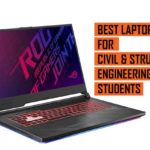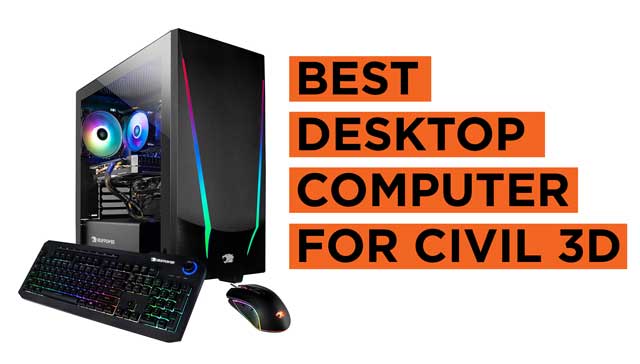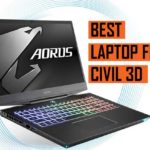This guide is built for civil engineers, structural designers, BIM coordinators, and infrastructure consultants who rely on professional-grade software to model, simulate, and document real-world projects. If you’re using tools like AutoCAD, Revit, SAP2000, ETABS, STAAD.Pro, Civil 3D, or Tekla Structures, this guide equips you with the technical insight to select a desktop PC that keeps pace with your project demands.
The challenge isn’t just raw performance, it’s balance. Engineering workflows demand both single-core speed for 2D drafting and model manipulation, and multi-core efficiency for simulation, rendering, and clash detection. You also need robust graphics processing for 3D visualization, high RAM capacity for handling large files and databases, and fast storage to support iterative saves and multi-software environments.
We’ve assembled a guide that evaluates desktop computers specifically tuned for engineering software. These systems support high-precision modeling, parametric workflows, load analysis, and collaboration across platforms. These desktops are equipped to deliver consistent, reliable performance for managing bridge dynamics, detailing RC slabs, or coordinating clash-free MEP routing,
We assess based on six core criteria: CPU performance, GPU capability, RAM size and speed, storage architecture, thermal reliability, and upgrade flexibility. Additionally, we only consider machines that meet a base specification of at least a 6-core CPU, 32GB of RAM, a professional or high-end consumer GPU with 8GB VRAM or more, and a 1TB NVMe SSD. This configuration is what modern engineering applications demand for smooth operation.
Let’s begin with the CPU. Many engineering programs, including AutoCAD, Civil 3D, and Tekla, prioritize high single-thread performance. Intel’s i7 or i9 (13th/14th Gen) and AMD’s Ryzen 7 or 9 (7000/9000 series) are ideal. For simulation software like ETABS, SAFE, or SAP2000, where multithreading matters during analysis runs, high core-count CPUs like the AMD Ryzen 9 7950X or Intel Core i9-14900K deliver significant gains.
Next, the GPU. While not all engineering applications are GPU-bound, 3D model rendering, large BIM model viewing, and point cloud management benefit from strong graphics hardware. NVIDIA’s RTX 4060 Ti, 4070, or professional-grade cards like the RTX A2000 or A4000 are well-suited for visualization and hardware-accelerated features in Autodesk and Bentley software.
Memory directly affects multitasking, data caching, and model load performance. 32GB RAM is the baseline, but many civil workflows benefit from 64GB or more, especially when running Revit alongside Navisworks, or loading geotechnical models into GIS-integrated platforms. Faster memory (DDR5 or DDR4 3200MHz+) also helps reduce bottlenecks during complex parametric changes.
Storage influences every task—from opening blueprints to exporting IFC files. We recommend a 1TB NVMe SSD as the system drive, providing fast boot times, reduced load screens, and responsive autosave. Pairing this with a second SSD or HDD for project archives and datasets improves file management and ensures quicker access to frequently used reference material.
Thermal stability is a silent factor in engineering reliability. Consistent performance during long simulations or rendering sessions requires efficient cooling. Workstations with tower-style CPU coolers, large front intakes, and optimized airflow avoid thermal throttling, ensuring your system performs at peak capacity even under sustained loads.
Lastly, upgradability matters for future-proofing. Engineering standards and software requirements evolve rapidly. A desktop with multiple DIMM slots, PCIe Gen 4 or 5 support, and modular PSU design will let you scale RAM, switch GPUs, or add storage as your project complexity grows.
All recommended systems in this guide come equipped with at least a 6-core high-frequency processor, an 8GB+ VRAM GPU, 32GB of fast memory, and high-speed SSD storage. They’re designed for sustained productivity, model accuracy, and dependable performance under the most common and critical civil and structural engineering tasks.
Also check: the best desktop computers for AutoCAD in addition to the best desktop Autodesk Inventor.
These are the Best Desktop Computers for Civil & Structural Engineering;
Contents
- Thermaltake Reactor 380 Liquid-Cooled PC (AMD Ryzen 7 5800X, RTX 3080, 16GB 3600Mhz
- iBuyPower Pro Y60 Gaming PC Computer Desktop Y60BI9N4701 (Intel i9-13900KF 3.0 GHz, Nvidia GeForce RTX 4070 12GB, 32 GB
- CyberPowerPC Gamer Supreme Liquid Cool Gaming PC, AMD Ryzen 7 8700G 4.2GHz, GeForce RTX 4060 Ti 16GB, 32GB DDR5, 2TB
- ASUS 2023 ROG G22CH Gaming Desktop PC, Small Form Factor, Intel® Core™ i9-14900KF, NVIDIA® GeForce® RTX 4070
- iBUYPOWER Y40 White Gaming PC Computer Desktop Y40WI7N46T02 (Intel Core i7 14700KF, RTX 4060Ti 8GB, 32GB
Thermaltake Reactor 380 Liquid-Cooled PC (AMD Ryzen 7 5800X, RTX 3080, 16GB 3600Mhz |
|
|---|---|
 See This On Amazon |
|
| CPU | AMD Ryzen 7 5800X |
| Processor Speed | 3.8 Ghz |
| GPU | RTX 3080 |
| Graphics Card Memory | 10 GB |
| RAM | 16GB |
| Storage Space | 1TB |
| Operating System | Windows 11 |
| Dimensions | 14 x 14 x 24 inches |
| Keyboard & Mouse | Sold Separately |
| Computer Monitor | Sold Separately |
| Advantages | Performance, Price |
| Disadvantages | Storage |
iBuyPower Pro Y60 Gaming PC Computer Desktop Y60BI9N4701 (Intel i9-13900KF 3.0 GHz, Nvidia GeForce RTX 4070 12GB, 32 GB |
|
|---|---|
 See This On Amazon |
|
| CPU | Intel i9-13900KF |
| Processor Speed | 3.0 GHz |
| GPU | Nvidia GeForce RTX 4070 |
| Graphics Card Memory | 12GB |
| RAM | 32 GB |
| Storage Space | 1TB NVMe SSD |
| Operating System | Windows 11 |
| Dimensions | 18 x 11.2 x 18.2 inches |
| Keyboard & Mouse | Included |
| Computer Monitor | Sold Separately |
| Advantages | Performance |
| Disadvantages | Storage |
CyberPowerPC Gamer Supreme Liquid Cool Gaming PC, AMD Ryzen 7 8700G 4.2GHz, GeForce RTX 4060 Ti 16GB, 32GB DDR5, 2TB |
|
|---|---|
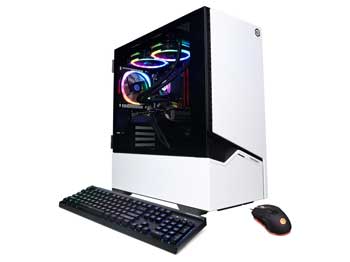 See This On Amazon |
|
| CPU | AMD Ryzen 7 8700G |
| Processor Speed | 4.2GHz |
| GPU | GeForce RTX 4060 Ti |
| Graphics Card Memory | 16GB |
| RAM | 32GB DDR5 |
| Storage Space | 2TB PCIe Gen4 SSD |
| Operating System | Windows 11 |
| Dimensions | 23 x 21.5 x 12.5 inches |
| Keyboard & Mouse | Included |
| Computer Monitor | Sold Separately |
| Advantages | performance |
| Disadvantages | None |
ASUS 2023 ROG G22CH Gaming Desktop PC, Small Form Factor, Intel® Core™ i9-14900KF, NVIDIA® GeForce® RTX 4070 |
|
|---|---|
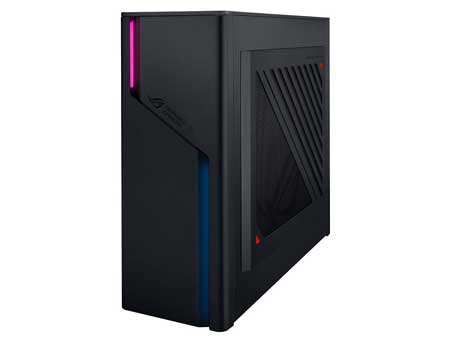 See This On Amazon |
|
| CPU | Intel® Core™ i9-14900KF |
| Processor Speed | 5.6 GHz |
| GPU | NVIDIA® GeForce® RTX 4070 Dual |
| Graphics Card Memory | 12 GB |
| RAM | 32GB DDR5 |
| Storage Space | 1TB SSD |
| Operating System | Windows 11 |
| Dimensions | 12.72 x 11.3 x 4.53 inches |
| Keyboard & Mouse | Sold Separately |
| Computer Monitor | Sold Separately |
| Advantages | Top performance |
| Disadvantages | Price |
iBUYPOWER Y40 White Gaming PC Computer Desktop Y40WI7N46T02 (Intel Core i7 14700KF, RTX 4060Ti 8GB, 32GB |
|
|---|---|
 See This On Amazon |
|
| CPU | Intel Core i7 14700KF |
| Processor Speed | 3.4Ghz |
| GPU | RTX 4060Ti |
| Graphics Card Memory | 8GB |
| RAM | 32GB DDR5 |
| Storage Space | 2TB NVMe |
| Operating System | Windows 11 |
| Dimensions | 21.6 x 21.6 x 14 inches |
| Keyboard & Mouse | Included |
| Computer Monitor | Sold Separately |
| Advantages | Performance, Storage |
| Disadvantages | n/a |
RELATED DESKTOP PCS RECOMMENDATIONS:
Best CATIA capable Desktop PCs
Latest Top Civil 3D Desktop computers


